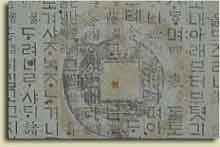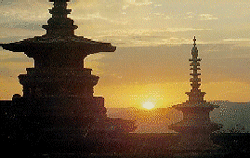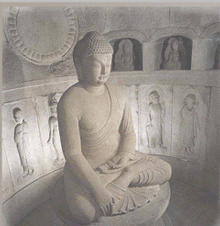| |
| |
|
Korean
Proverbs - Group 1
Korean Proverbs
- Group 2
Korean Proverbs
- Group 3
Korean
Claim To Be
True Descendants Of Dongyi (Easter Yi) |
Starting is half the task.
Power
lasts ten years; influence not more than a hundred.
Cast no dirt into the well that gives you water.
Even if the sky falls on you, there is a hole that you can escape from.
The deeper the waters are, the more still they run.
A turtle travels only when it sticks its neck out.
Even a fish wouldn't get into trouble if it kept its mouth shut.
Put off for one day and ten days will pass.
Words have no wings but they can fly a thousand miles.
A kitchen knife cannot carve its own handle.
After
losing a cow, one repairs the barn.
One
can build a mountain by collecting specks of dust.
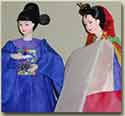
|
| |
|
|
No
one knows exactly where the Koreans came from or who they are.
It is believed
that the humanoid - human-like creatures - appeared about two and half
million
years ago and that the humans as we know today, homo sapiens sapiens,
came
into being some 35,000 years ago. Although the oldest known writings
- written
language - date back only 5,000 years at best, we can 'read' our history
by studying
fossils, our DNA, geological data, cosmological data, our language,
and so on, and
from these records, we can determine the origin, or rather the prehistoric
history,
of the Korean race, the baik-yi-min-jok - the 'White-clad People'
(called "Dong-yi"
-- the eastern barbarians, 동이족
東夷族" and also 예맥족
濊貊族 by the Chinese
historians).
Koreans
are classified as the Mongoloid (the 'yellow' race) along with Chinese,
Japanese, Native Americans, Mongols, Eskimos, and so on. The Yellow
race makes
up 33% of the world population. The Caucasoid (the "white"
race), including the
Australian aborigines, Arabs, Indians, Polynesians, and so on, accounts
for 59%
of the world population, while the Negroid (the 'black' race) accounts
for only 8%.
It is believed the Negroid and Caucasoid are more closely related than
the
Mongoloid, which gave rise to the regionalism hypothesis whereby the
Mongoloid
has evolved from homo erectus while the Negroid and the Caucasoid have
evolved
from a common ancestor homo antecessor.
|
| |
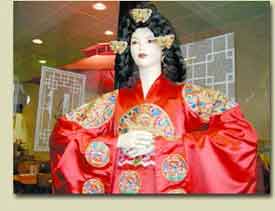 |
|
| |
|
|
Early
Korean literature was heavily influenced by Shamanism, Buddhism and
Confucianism. The early literature, which began as an oral tradition,
depicted a
love of nature and man and held that man was a part of nature. Good
was rewarded
and evil was punished and values like loyalty to the King, filial piety,
respect for one's
elders, true friendship and chastity were emphasized. Some of the earliest
Korean
writings were poems, called hyangga,
written during the Shilla Kingdom using the
script type Idu partially adapted from Chinese characters phonetically,
only 25
remain. During the Koryo period, Korean literature of the upper class,
mostly written
in classical Chinese, was characterized by an emphasis on philosophic
expositions
on the Chinese classics, an art that was essential for government service,
the only
respectable avenue to success outside of teaching. |
| |
|
|
|
The
character 'Yi', as shown above, was originally meant for barbarians
in the east,
but later expanded to be more an inclusive word to mean aliens. The
big Korean
school of thought, touched on in prehistory section, claimed that the
Koreans were
true descendants of the Dongyi [Dong-yi] people.
Hence,
the identities of Koreans had changed dramatically during the course
of
history. As one reader speculated, "modern-day Koreans" might
very well have
"appropriated their (Dongyi) history and myths". Charcoal
remains of
2000-year-old rice in western Japan pointed to China's Yantze Delta
as the
origin. DNA studies conducted on human remains excavated in Shandong
Peninsula
suggested southern and northern points of origin for Jormon and Yayoi
Japanese.
On basis of various historical records and modern technology analysis,
I would speculate:
i) that early Korean culture was very much connected with eastern China
as a
result of nascent human migration from south to north and ii) that Tungusic
invasions from Manchuria gradually overtook the early Continental traits.
In
both cases, Tungusic or continental, Koreans shared inseparable relations
with the Chinese. |
|
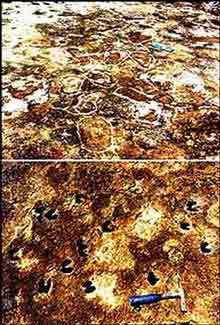
Photo
courtesy of OhMyNews. |
50,000-year
old Footprints
The
Cheju footprints are 8.4 by 10 inch in size (note
the hammer in the photo for comparison) and show
sharp details of the heels, medial arches and balls.
In addition to the human footprints, the sedimentary
fossil rocks contain footprints of elephants, horses,
deer. and birds as well as remains of fish, mollusks
and sea plants.
Prof. Kim believes that the footprints contain enough
information for him to reconstruct the physical
features of the Cheju Stone Age people. Modern
digital reconstruction technology developed for
forensics can be used to draw detailed pictures of
our ancestors that inhabited this remote island
some 50,000 years ago.
It is believed that the East Sea was once an inland
lake surrounded by the Japanese islands, Cheju,
the Philippines, and the Asian continent, and Cheju
was a mere volcano (Mt. Hanra) in a vast continent
where elephants and other Stone Age animals roamed. |
|
Korean
Traditional Colors
 |
Traditional
Clothes

|
BIBLIOGRAPHY
David Adams Leeming, The world of myth, New York, Oxford University
Press,
Inc., 1990, p. 3 Ibid., p. 4
Richard Cavendish, Mythology an Illustrated Encyclopedia, New York,
Rizzoli
International Publications, Inc., 1980, p. 11
Zong In-Sob, Folk Tales From Korea, Seoul, Hollym Corporation: Publishers,
1970, p. 3-4
Sheila Savill, Pears Encyclopaedia of Myths and Legends, The Orient,
London,
1977, p. 19
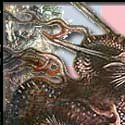 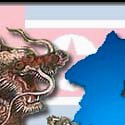 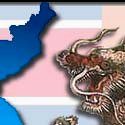 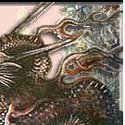
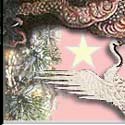 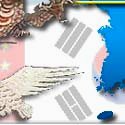
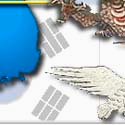 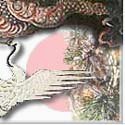
Korean
National Anthem
Compiled
by: Glenn Welker
Return
to Korean Literature
|



